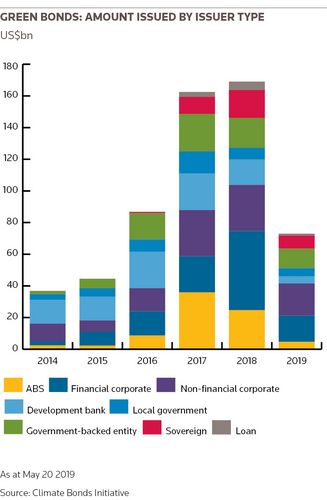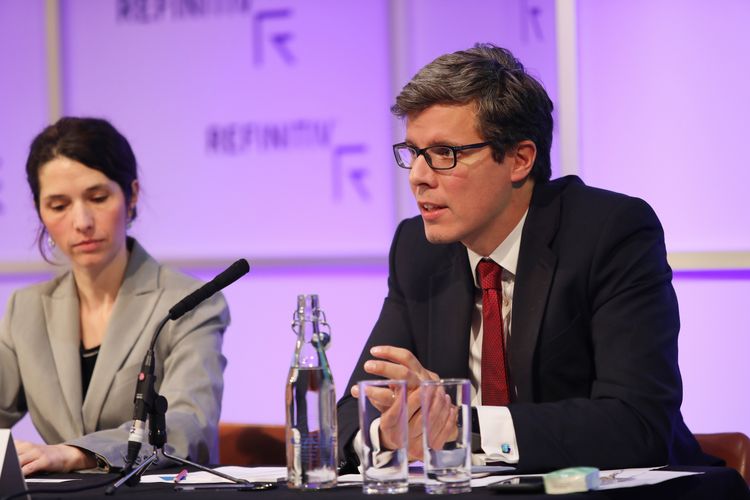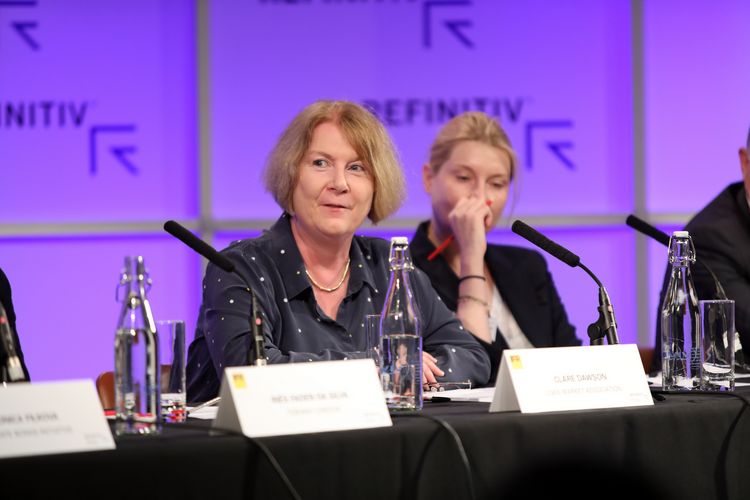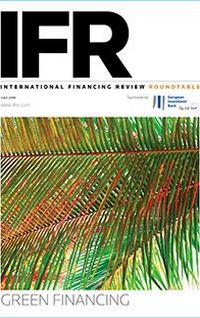Keith Mullin, KM Capital Markets: If the market morphs from a market where issuance is assessed purely on the use of proceeds to perhaps a more convoluted situation where people have to weigh up the overall footprint of the issuer, how do you calibrate that? Who decides and how do you decide whether the footprint of the issuer is sufficiently sustainable, environmental, to then pass muster at the corporate level? CBI plays quite a big role in that calibration. Most of the Green bond indices are defined by your imprimatur, so you have quite a big role to play here. If the market shifts from assets to issuer, it strikes me that that creates some quite significant challenges.
Monica Filkova, Climate Bonds Initiative: It does pose a challenge, and historically investors have looked at companies more than the way they’re financed, in the sense that you look at the company and decide if it meets your requirements. One of the ESG requirements could be: ‘don’t invest in oil’. If one of your requirements is ‘don’t invest in oil’, how do you participate in a Green bond that’s issued by a company in the oil and gas sector?
It remains a challenge. The way we look at it is really defined by the activities and assets. We’ve actually seen a lot of issuance from utility companies as they fund their transition to a greener asset portfolio and that is expressed in renewable energy in the context of the energy sector. They keep coming back to the market. What that tells us is that they’re really engaged with this transition strategy. As a general point, we acknowledge that transition is required. It would be great if you could just snap your fingers and we’ve transitioned, but the reality is companies need to move from A to B. One way to indicate that transition is by labelling.
One of the main achievements of the Green bond market is the label itself because it has support from a very wide stakeholder group. Whether you agree about a particular bond and whether it meets your definition of what a Green bond should be is, in a sense, not quite so important. What the label achieves is a communication of corporate intentions.
CBI recently conducted an investor survey. One of the things we confirmed is the level of engagement: a lot of the investors we spoke with – even though they’re bond investors – are engaging with companies. The questions they are asking are about the wider strategy. We see that sentiment, that Green bonds are part of a strategy, over and over again. One of the things that keeps coming across is that, if you label something green as an issuer, you’re taking on an obligation to report. You’re taking on an obligation to keep investing in the asset you said you would invest in and, from the reporting, people can see you are doing what you say you will do. It’s not just words; it is followed up by actions. That gives us comfort that, when companies engage with the market, it is part of a wider environmental strategy.
The way we look at the market is very much from the assets. That’s why we look at transitioning companies; we look at pure-play companies; we look at various institutions that are looking to fund or facilitate the issuance of debt, whether that’s loans, bonds, some other form of debt to finance the transition to a low-carbon economy.
When we do our screening, we’re looking to see that practically all of the funding is going towards climate assets so once you invest in those assets, those assets will continue providing a climate benefit. Simply put, if you invest in a wind farm, the wind turbines will keep spinning year after year so once you’ve made an investment, that’s positive; it has a long-term impact.
We screen out companies that are allocating a substantial amount, for example, to general corporate purposes or categories that are unclear. In China, the Green bond catalogue allows up to 50% to be invested in general corporate purposes. We tend to screen out quite a lot of companies for that because it’s unclear to us what the money is going towards. If we know the money is going towards green assets, then we’re OK with it.
Stuart Kinnersley, Affirmative Investment Management: I think it’s quite clear, actually. Integrity of the market is paramount because it’s relatively new and people who invest in Green bonds believe they are supporting transition. Engagement is really important: looking at the issuer as to what their real intentions are. If it’s an issuer whose business model is all about fossil-fuel extraction and they may be allocating 1% or 2% to investing in wind farms, to us that’s not moving the dial; it’s actually undermining the integrity of the market and it’s really important at this stage that there’s no confusion or ambiguity.
That doesn’t mean we will not invest in less green entities. In fact, we’ve invested in utilities that are predominantly using fossil fuels at present but management have a clear ambition and a map to increase renewables to a meaningful percentage. That’s what I call supporting transition.
I think it’s really important because there are lots of mainstream investors out there who would love just to take the label and put it in their portfolio and tick the box – this is when I talk about greenwashing. It can come from the issuer and it can come from the investor. If we start to do that then I think the general public or institutions are not stupid and it would potentially kill off the market, which I see as potentially being one of the drivers for change in sustainable finance.
Keith Mullin, KM Capital Markets: Darko, let me come to you. As a venue with a global brand, what is the London Stock Exchange doing to further the cause of green finance? How important is it for stock exchanges to be part of this debate?
Darko Hajdukovic, London Stock Exchange: Stock exchanges are infrastructure companies and meeting places for investors and issuers. What we’re doing at London Stock Exchange falls into several categories. One is ensuring there is sufficient data and information so that we don’t just end up labelling things and saying: ‘it’s a Green bond because it does one thing’ but then it doesn’t do other things. Or in trying to achieve something good, issuers aren’t failing in other aspects.
We’re trying to create a holistic framework. This is where we’re different from other marketplaces in this space. On one side, we have our markets where companies list their securities and their investment funds, which is very important and a growing part of the market. And of course companies. What is common among all these three categories is that, through listing, companies will be providing disclosures that can be used by investors and information providers to give and extract data that is relevant for green investing and sustainable investing.
For example, through FTSE Russell, we cover 97% of global market capitalisation. Over 10,000 companies are included in our very detailed datasets, which we make available to investors to assess impact investing. As Stuart said, all investing has an impact; how do you quantify the impact of that investing?
In terms of bond listings, we started with one bond in 2007 and we have seen gradual but steady growth. There are now 107, a mixture of corporates and supranationals from the UK, Europe and Asia. What’s interesting is that 36 of those bonds have listed in the last two years so you can definitely see how it’s accelerating. Funds started in 2013 and they had a slightly different dynamic. We had five funds come to the market in 2013 in renewable energy and today we have 22.
In fact, one of those funds is now responsible for production of 0.5% of the UK’s electricity, all from renewable energy. What we’ve seen in that market is evolution. Funds changed from owning wind and solar farms to efficiency funds and solar funds. Just recently, we welcomed the first US solar fund, which is investing in the US. It’s not just the UK anymore; it’s global.
Then we have listing of companies themselves. What’s interesting about the companies is, because of the data I mentioned and the taxonomy that FTSE Russell has developed, we can actually say what part of the revenues of our market are generated from green. It’s 20%, equivalent to about £275bn of market capitalisation. This is a headline figure but, actually, what we have underneath that are very detailed datasets that we provide to investors and we provide solutions so they can quantify their investments, their portfolios and how they are performing against their objectives supporting climate change.
It’s not just about labelling; it’s looking beyond that. How do we make sure that there is investing with confidence and issuing in a marketplace that will provide investor confidence?
Keith Mullin, KM Capital Markets: In terms of how the market moves forward, we’ve touched on the principles that have been put in place for Green and Sustainable bonds and loans. In the EU, we are moving towards a more regulated market with formal definitions. What is the EU taxonomy going to look like? Will it be radically different to what we have now? Will it be a game-changer?
Dominika Rosolowska, EIB: The short answer is that it has the potential for being a game-changer. Looking at what has been happening in the Green bond market, one area where it is extremely difficult to find consensus is how you define what is actually green.
Every player in the market, be they an investor, an issuer, or an NGO, has a different definition of what is green. In fact, when you look at the use of proceeds of the Green Bond Principles, for instance, it lists examples of project categories. Given these different definitions and the lack of scientific consensus as to what can be classified as green, guidance is needed from policymakers based on consensus facilitated by market-neutral public policy intervention. In fact, such intervention is needed to ensure a level playing field. Here, the European Commission has been acting in the context of the Capital Markets Union.
The EC’s Technical Expert Group on Sustainable Finance has four work streams. One is focused on taxonomy, one on disclosure, one on benchmarks and the other on the EU Green Bond Standard, which is the one that I have been involved in. The mandate of the taxonomy sub-group is to define what is green. It is called a sustainability taxonomy, but the EC’s 2018 regulation proposal specified that environment should be the first focus of this work. And within environment, climate should be the first area. [The TEG’s draft taxonomy was published on June18].
The EU Green Bond Standard is based on the taxonomy. Whatever comes out of the taxonomy discussion has a direct impact on the assessment of financial products, starting with EU Green bonds. There was a public consultation by the TEG on the draft EU Green Bond Standard in March that presented the ideas we had as to what this should look like. It is going to be conceived as a voluntary standard based on best market practices like the Green Bond Principles, while at the same time introducing clarifications – as Cristina mentioned – for instance with regard to the type of assets and expenditures eligible for allocations.
Monica Filkova, Climate Bonds Initiative: Sean Kidney, CEO of Climate Bonds Initiative, is also part of the Technical Expert Group and we’ve had a standard since 2010 and a taxonomy that has been updated pretty much on an annual basis since it was first published in 2013. We’ve always used a taxonomy that we’ve shared with the market. But even though we might have a standard or there’s an EU standard, investors are actually, in a sense, obliged to do their own analysis.
One thing we’ve been working on over the last year is expanding the number of sectors for which we have specific criteria for certification. Our criteria for certification are similar to what the EU is trying to achieve in setting definitions of what is green. In other words, what sort of metrics would an asset need to achieve to determine that it is compliant with the Paris Agreement or a scenario where global warming was to be kept under 2°C?
Defining these criteria is incredibly time-consuming and complicated. There are technologies that come into play. So, while taxonomies and standards do provide a rulebook, if that rulebook becomes part of guidance or regulation then it has wider implications. The market is evolving and in our day-to-day work we’re seeing an increasing number of issuers financing new sectors and new aspects. In response, one of the things CBI is doing at the moment is looking further at adaptation and resilience. A lot of Green bond issuance to date has focused on climate change mitigation. Adaptation and resilience are an increasing part of the mix. It needs to be part of the mix because, unless your infrastructure is resilient, the fact that it delivers other benefits is neither here nor there if it’s damaged by the first flood or a rise in sea levels.
There will always be aspects that are unclear, that are under development, or that require discussion. We really welcome not just the work that the EU is doing in terms of defining a taxonomy and trying to harmonise definitions, but what’s also really important is the impact of the Task Force on Climate-related Financial Disclosures (TCFD) and, in general, disclosure regulations.
As much as we like to have a tick-box to determine that a bond is green up-front, one of the really important things is disclosure and ongoing information. If a company is providing more information, informed opinions about what it is doing, what the broader asset mix is, what its strategy is for addressing climate risks etc, you can always make better decisions on a particular issue. Everybody needs to make their own assessments but, to do that, you need disclosure. Any initiative that brings forward that discussion, we’ll embrace it.
Darko Hajdukovic, London Stock Exchange: That’s absolutely right. I think the taxonomies and standardisation of definitions are important, but there is a balance that needs to be struck here and that is that we can classify things but it’s important that investors make those decisions. They’re going to make decisions on the basis of detailed information that companies provide.
Every company that’s listed on our market will have access to a lot of data from London Stock Exchange. One of the data points is their green score. We are hoping that when companies view their scores and see how they benchmark against others in their industry sector that this will provide an incentive for them to improve. We’re not only providing the score, but we also give them ESG guidance to improve it.
Of course, one of the important aspects of this is not just what companies are doing, as Stuart alluded to, but about what companies are planning to do. What’s the governance framework in which companies are doing it? That, I think, is very important in ensuring that a company does go through that transition into a more sustainable commercial model.
Ines Faden, Tideway: I’d like to provide the corporate view on this. You have a number of standards, taxonomies and reporting requirements that are being left to companies to implement. But there is a balance that needs to be achieved. If I go to my board and say I need to set up a mini cottage industry to produce these reports, I know what they’re going to tell me. On the other hand, a company that is doing the right things will have that information in-house. If someone has to produce new information to report, they shouldn’t be doing it in the first place. There’s an important balance here.
In January, 16 European companies came together – we’re now 21 companies – representing about two-thirds of European Green bond issuance to create the Corporate Forum on Sustainable Finance to address a number of issues to collaborate, exchange information, assist with how best to report, but also to have a voice in this process. Corporates have been under-represented [in this discussion] even though we’re the ones left to implement a lot of these things.
We’ve responded to the EU consultations on taxonomy and on the Green Bond Standards. What I would say is that, while corporates welcome the initiative, there’s a lot of commentary on the detail and not all of it has been particularly popular. I always ask: ‘What is the problem we’re trying to solve?’. A concern I would have is that if we go too far in one direction – and we’re already seeing it – and rather than issuing Green bonds, people are going down the route of ESG-aligned or SDG-aligned, it’s much easier and much broader.
Companies that have issued Green bonds are at the forefront; they’re the ones you don’t need to convince. They’re committed. But at the same time, they’re a little concerned that it could go too far in one direction – either the definitions are too narrow or there are too many requirements. Bear in mind there are initiatives at the national level, European Union level, global level, and at the level of associations. The regulators are coming up with something, as is the British Standards Institute. People want to report, but they want to go about their normal business as well.
Dominika Rosolowska, EIB: One thing that you mentioned – it also came up in the CBI’s intervention – is the fact that the EU is just one of the jurisdictions where you have this kind of process. We’ve had the China Green bond catalogue that’s been there since 2015. In other jurisdictions around the world, you have policymakers and authorities looking at defining what is green, as well as setting the core features of green financial products.
The important component of this process, and this has been one of the EU’s explicit objectives, is that you make taxonomies – or classifications – comparable. Otherwise barriers built will prevent cross-border financial flows. With this in mind, the EU is striving to structure its taxonomy in a way that would permit this comparison. You have this idea of objectives and activities and technical screening criteria. Green eligibility thresholds can then be compared with those set up in other jurisdictions.
Classification is one part. The important thing is measurement and disclosure. That’s definitely the pillar of the thinking of the EU and others in this market. The question is how you measure things and how you report things. As CBI mentioned, you have 200 metrics just for calculation and reporting greenhouse gas emissions. There should be more standardisation, more harmonisation of this information so that it can be processed by investors to make decision-making more efficient. This is also what the EU is trying to address through the coordinated discussion on the EU Green Bond Standard and disclosures.
Cristina Lacaci, Morgan Stanley: Just going back to the comment around the taxonomy, I think it’s very useful to have definitions and it really helps us when we’re trying to structure bonds. But at the same time, you need to take into account that some projects are easy to categorise - like renewable projects, clean transportation, green buildings - but others can be very difficult to classify.
It doesn’t mean that they’re not contributing positively to the environment; it just means that it’s more difficult to include them in a certain category, particularly when you look at industrial companies and manufacturing companies. The taxonomy will be useful, but we’ve only seen half of the activities covered in their first objective (…and that’s 100 pages). It’s going to take us several years just to have the full list, which will have to be updated on an ongoing basis.
Going back to the previous comment, it’s important to look holistically at what the company is doing and how it is performing on key ESG metrics (for example, are its CO2 emissions going down, what is its water intensity?). It’s important not to miss the bigger picture.
Clare Dawson, LMA: It’s really important to bear in mind that corporates’ main focus is on running their business. We can’t create frameworks that make it so difficult to do that, whether it be reporting or classifying things in the first place; that just puts people off. You really can go down the route of the perfect being the enemy of the good. We involved the Association of Corporate Treasuries in our working group when we produced our sets of principles because we were keen to have a borrower voice. But I think also that was one of the reasons why we produced relatively high level principles. Particularly in the loan market, because there is this close relationship between lenders and borrowers, we do feel that there should be flexibility below a set of principles for people to look at the detail and what actually works in an individual situation or an individual company, because that’s not going to be a one-size-fits-all solution.
Stuart Kinnersley, Affirmative Investment Management: I would echo a lot of the comments made. We were asked our opinions, and gave them and pushed back on certain things, but I think the important thing here is that every bond that we look at has its own nuances. If you have a straightjacket, this market is still young and it’s still growing, we really don’t want to stifle innovation or issuance. We need issuers to come to grow this market; that’s my concern.
To see the digital version of this roundtable, please click here
To purchase printed copies or a PDF of this report, please email gloria.balbastro@refinitiv.com





